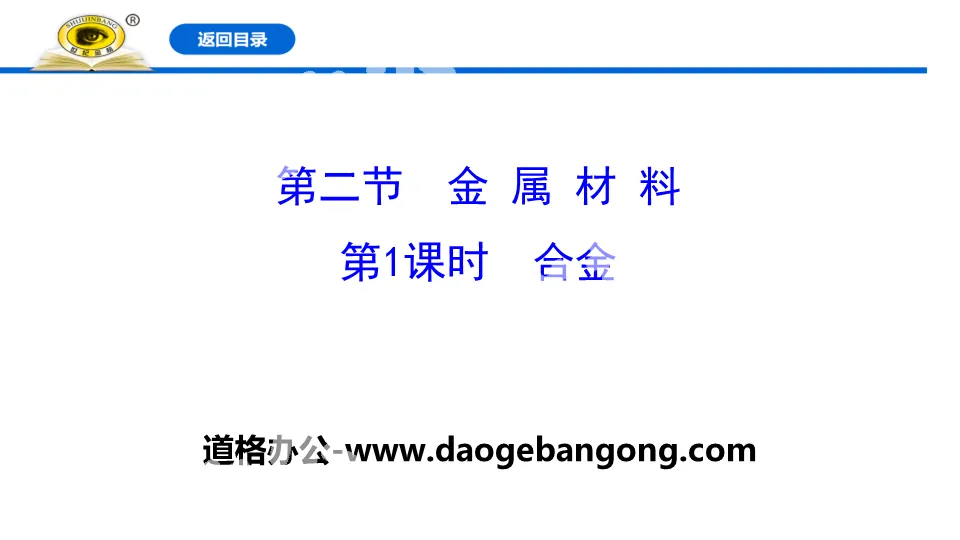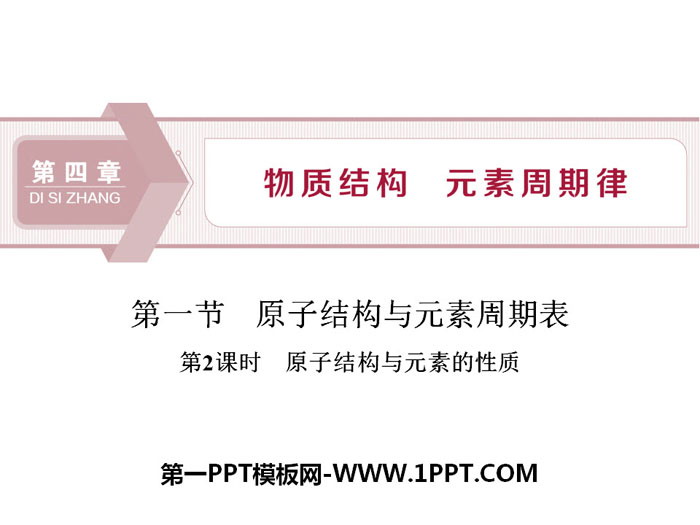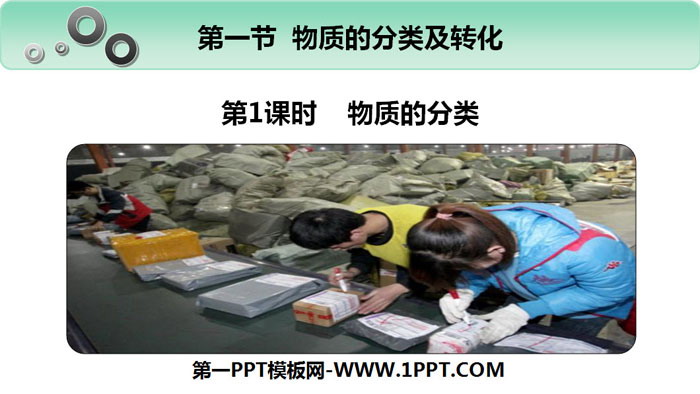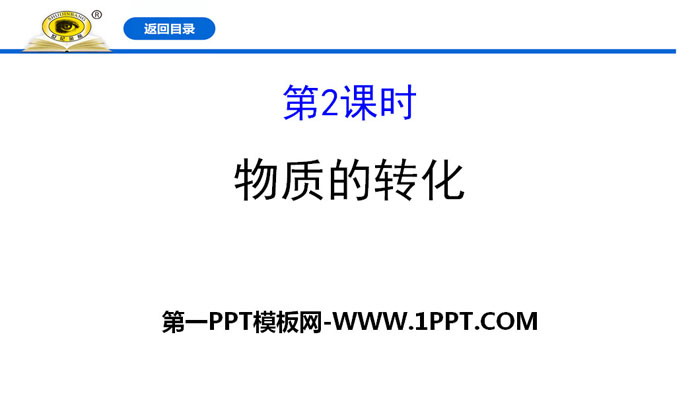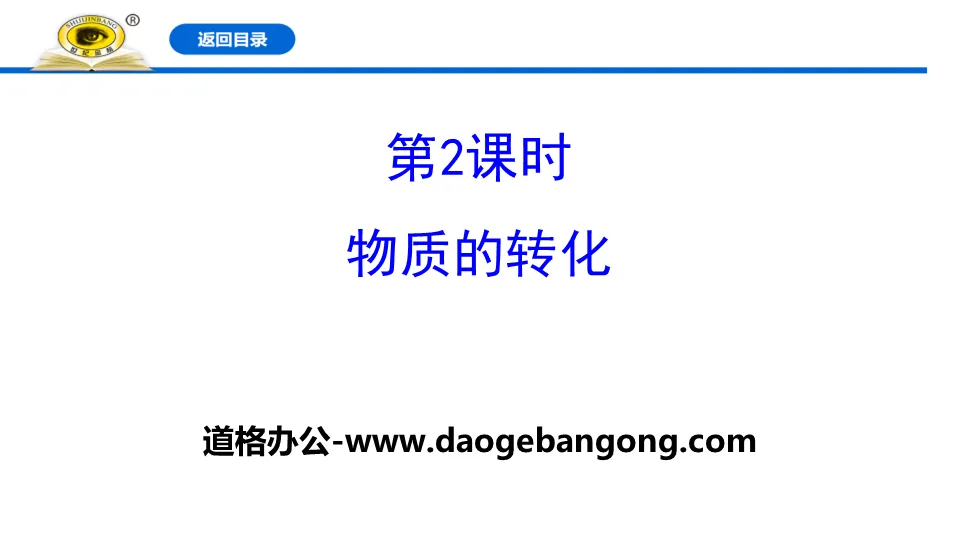
| Category | Format | Size |
|---|---|---|
| People's Education Press High School Chemistry Compulsory Course I | pptx | 6 MB |
Description
"The Application of the Amount of Substance in the Calculation of Chemical Equations" Metal Materials PPT
Part One: Goals and Competencies:
1. Understand the relationship between stoichiometric numbers and each stoichiometry in chemical equations. (model cognition)
2. Master the application of the quantity of substances in the calculation of chemical equations. (Model Cognition and Scientific Spirit)
PPT on the application of the amount of matter in the calculation of chemical equations, part 2: independent preview to explore new knowledge
1. The relationship between stoichiometric numbers and each stoichiometry in chemical equations
2Na++2H2O===2NaOH+H2↑
Mass ratio: 46 g: 36 g: 80 g: 2 g
Ratio of measurement numbers: 2 ∶ 2 ∶ 2 ∶ 1
Expand NA times: 2NA ∶ 2NA ∶ 2NA ∶ NA
Ratio of amounts of substances: 2 mol ∶ 2 mol ∶ 2 mol ∶ 1 mol
Conclusion: The ratio of stoichiometric numbers in chemical equations is equal to the ratio of ______, which is also equal to the ratio of ______. For reactions involving gases, it is also equal to the ratio of ______.
Why do the units of the same substance have to be unified when calculating using chemical equations, but not different substances?
[Tips] When the same substance is expressed by different physical quantities, the proportions are the same. For example, 1 mol of sodium is exactly the same as 23 g of sodium.
2. “Three Standards” in Calculating the Amount of Relevant Substances
1. Writing standards
The writing of various symbols should be standardized. The meanings of uppercase letters and lowercase letters are different. For example, "M" represents ________, and "m" represents ________, "N" represents the number of particles, and "n" represents ________.
2. Symbol convention
(1) Assume that the unknowns are directly represented by the symbols of each physical quantity, and the symbol of the substance (or particle) must be noted. For example, assume that the volume of the HCl solution participating in the reaction is V HCl(aq)].
(2) Various physical quantities and units, names of substances, formulas, etc. should be represented by symbols as much as possible. If the volume of the NaOH solution and the mass concentration of the substance are known, when finding the mass of the NaOH solution, it can be written as: m(NaOH)=____________________________.
3. unit specifications
When substituting known quantities into calculation formulas, units must be used and the units must be unified.
The application of the amount of matter in the calculation of chemical equations PPT, the third part of the content: core breakthroughs and overcoming difficulties
Methods for calculating quantities of substances in chemical equations
1. Basic steps
2. Precautions for applying the amount of substance in the calculation of chemical equations
(1) The ratio of the stoichiometric numbers of each substance in the chemical equation is equal to the ratio of the quantities of each substance, not the ratio of mass.
(2) When calculating, various substances are not necessarily expressed by the amount of the substance, but can also be expressed by the mass. Gaseous substances can also be expressed by the volume, but attention should be paid to the conversion relationship between the amount of the substance and other physical quantities; as long as Just go to "the top and bottom are the same, the left and right are equal".
[Typical example] 1.15 g of metallic sodium reacts with water to obtain 100 mL of solution. Trial calculation:
(1) The volume of the generated gas under standard conditions is
__________________________________________________.
(2) The amount and concentration of the solute in the solution obtained after the reaction
__________________________________________________.
1. 0.56 g calcium oxide reacts with 20 mL hydrochloric acid, then the concentration of this hydrochloric acid is ()
A. 0.10 mol·L-1B. 0.20 mol·L-1
C. 0.50 mol·L-1 D. 1.00 mol·L-1
D CaO+ 2HCl===CaCl2+H2O
56 g 2 mol
0.56 g c(HCl)×20×10-3 L
Then: 56 g0.56 g=2 molcHCl×20×10-3 L,
The solution is c(HCl)=1.00 mol·L-1. ]
2. When a mixture of 1 mol Na and 1 mol Al is put into enough water, the volume of the gas produced under standard conditions is ()
A. 11.2 L B. 22.4 L
C. 33.6 L D. 44.8 L
D Calculation based on chemical equation:
2Na+2H2O===2NaOH+H2↑
twenty one
1 mol 0.5 mol
2Al + 2NaOH + 2H2O===2NaAlO2 + 3H2↑
twenty three
1 mol 1.5 mol
Therefore, Na and Al react completely to generate 2 mol H2, and the volume under standard conditions is 44.8 L. ]
Commonly used methods in chemical calculations
1. Difference method - an ingenious solution to the calculation of chemical equations
The difference method can be used when the amount of substances changes before and after a chemical reaction. The general steps to solve the problem are
(1) Accurately write the chemical equation of the reaction.
(2) Analyze the meaning of the question in depth and detail. The key is to find out the "object" and "theoretical difference" that cause the difference in a targeted manner. The "theoretical difference" can be mass, amount of substance, gas volume, pressure, etc., and the size of the difference is proportional to the relevant amount of substances participating in the reaction.
(3) According to the reaction equation, find the proportional relationship from the "actual difference" and solve it by formulating the proportional formula.
2. Relational expression method - a shortcut to solve continuous reaction type calculation problems
When the known quantity and the unknown quantity are connected by multiple reactions, it is only necessary to directly determine the proportional relationship between the known quantity and the unknown quantity, that is, the "relational expression".
(1) Determine the relationship based on chemical equations
Write the chemical equation for the reaction and write the relationship based on the quantity relationship.
(2) Determine the relationship formula based on atomic conservation.
PPT on the application of the amount of matter in the calculation of chemical equations, Part 4: Testing in class to improve literacy
1. For the reaction aA+bB===cC+dD (A, B, C, D represent the chemical formula of the substance, a, b, c, d are the stoichiometric numbers in the chemical equation), which of the following statements is incorrect ()
A. If A with mass m1 and B with mass m2 react completely, the sum of the masses of the generated C and D must be equal to (m1+m2)
B. The total number of atoms in A and B participating in the reaction must be equal to the total number of atoms in C and D produced.
C. (a+b) is not necessarily equal to (c+d)
D. The types of elements in A and B are not necessarily the same as the types of elements in C and D.
D Conservation in chemical reactions includes not only conservation of mass, but also conservation of element types and number of atoms, so D is wrong. ]
2. Put a small piece of sodium into enough water and the following reaction will occur: 2Na+2H2O===2NaOH+H2↑. Which of the following statements about this reaction is correct ()
A. The masses of Na and NaOH in the reaction are equal
B. The masses of H2O and H2 in the reaction are equal
C. The mass ratio of H2O and H2 in the reaction is 2:1
D. The ratio of the amounts of Na and NaOH in the reaction is 1:1
D: In this reaction, the amount ratio of Na to NaOH is 1:1, and the mass ratio is 23:40, so item A is wrong and item D is correct; the amount ratio of H2O to H2 is 2:1, the mass ratio is 18:1, so items B and C are both wrong. ]
3. Add sufficient aluminum powder to 500 mL NaOH solution. After the reaction is complete, a total of 33.6 L of gas under standard conditions is collected. The substance concentration of the NaOH solution is ()
A. 1.0 mol·L-1B. 2.0 mol·L-1
C. 1.5 mol·L-1 D. 3.0 mol·L-1
Keywords: Free download of the PPT courseware for high school chemistry compulsory course 1 of the People's Education Press, PPT download of the application of the amount of matter in the calculation of chemical equations, PPT download of metal materials, .PPT format;
For more information about the PPT courseware "Application of the Amount of Substance in the Calculation of Chemical Equations of Metal Materials", please click the "Application of the Amount of Substance in the Calculation of Chemical Equations ppt Metal Materials ppt" tag.
"Application of the Amount of Substance in the Calculation of Chemical Equations" Metal Materials PPT Download:
"The Application of the Amount of Substance in the Calculation of Chemical Equations" Metal Materials PPT Download Part One Content: Literacy Objective 1. Review and review the relationship between the quantity of substance n and the number of particles N, the mass of the substance m, the gas volume V, and the solution concentration c The calculation formula consolidates the amount of substance as...
"The Application of the Amount of Substance in the Calculation of Chemical Equations" Metal Materials PPT Courseware:
"The Application of the Amount of Substance in the Calculation of Chemical Equations" Metal Materials PPT Courseware Part One Contents: Foundation of Essential Knowledge Literacy 1. Relationship between the Amount of Substance and Each Physical Quantity 1. Illustrated Relationship 2. Calculation Formula (1) has been Know the mass of the substance: n(B)=_______; ..
File Info
Update Time: 2024-07-04
This template belongs to Chemistry courseware People's Education Press High School Chemistry Compulsory Course I industry PPT template
"The Application of the Amount of Substance in the Calculation of Chemical Equations" Metal Materials PPT Simple campus recruitment activity planning plan summary enterprise and institution recruitment publicity lecture PPT template is a general PPT template for business post competition provided by the manuscript PPT, simple campus recruitment activity planning plan summary enterprise and institution recruitment promotion Lecture PPT template, you can edit and modify the text and pictures in the source file by downloading the source file. If you want more exquisite business PPT templates, you can come to grid resource. Doug resource PPT, massive PPT template slide material download, we only make high-quality PPT templates!
Tips: If you open the template and feel that it is not suitable for all your needs, you can search for related content "The Application of the Amount of Substance in the Calculation of Chemical Equations" Metal Materials PPT is enough.
How to use the Windows system template
Directly decompress the file and use it with office or wps
How to use the Mac system template
Directly decompress the file and use it Office or wps can be used
Related reading
For more detailed PPT-related tutorials and font tutorials, you can view: Click to see
How to create a high-quality technological sense PPT? 4 ways to share the bottom of the box
Notice
Do not download in WeChat, Zhihu, QQ, built-in browsers, please use mobile browsers to download! If you are a mobile phone user, please download it on your computer!
1. The manuscript PPT is only for study and reference, please delete it 24 hours after downloading.
2. If the resource involves your legitimate rights and interests, delete it immediately.
3. Contact information: service@daogebangong.com
"The Application of the Amount of Substance in the Calculation of Chemical Equations" Metal Materials PPT, due to usage restrictions, it is only for personal study and reference use. For commercial use, please go to the relevant official website for authorization.
(Personal non-commercial use refers to the use of this font to complete the display of personal works, including but not limited to the design of personal papers, resumes, etc.)
Preview





